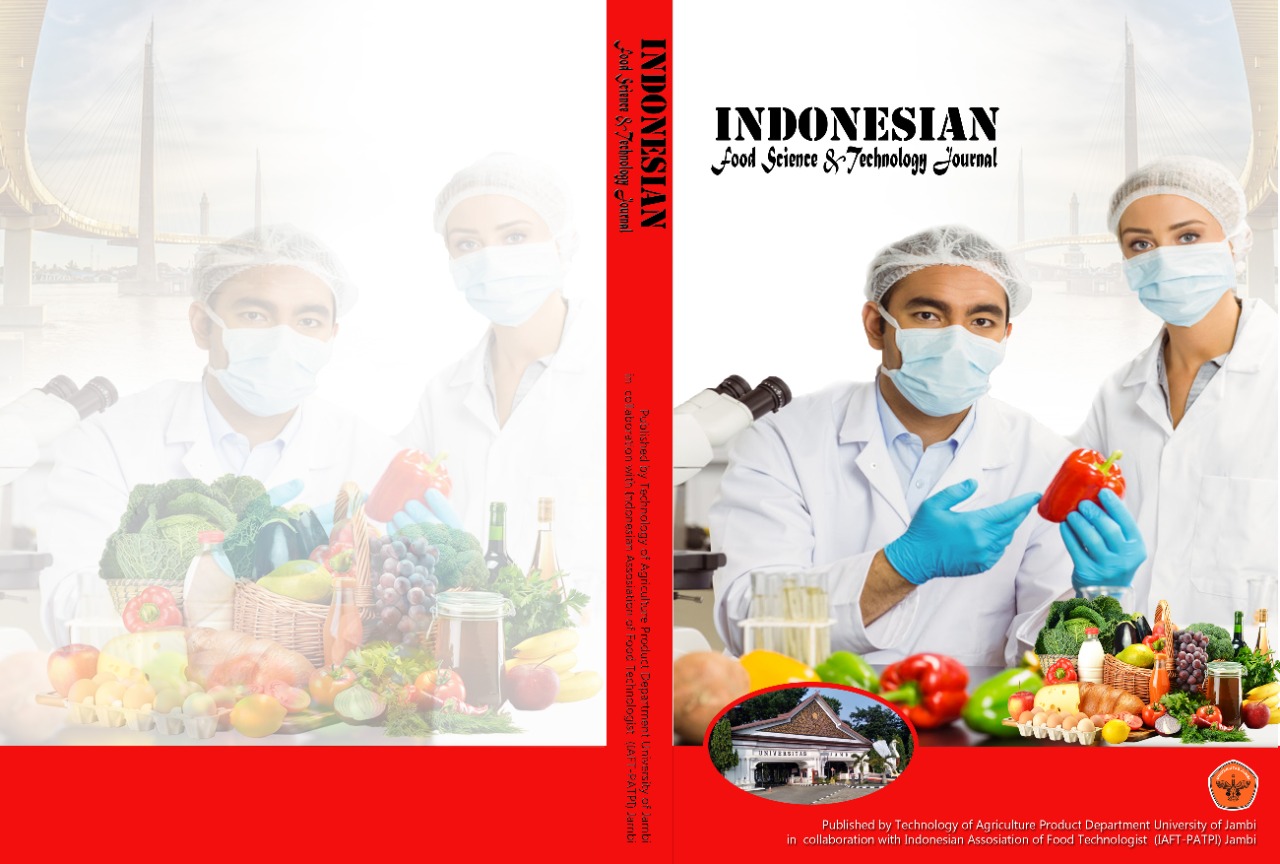Effect of Different Particle Sizes on The Akara Making Potentials of Pigeon Pea Flour
DOI:
https://doi.org/10.22437/ifstj.v5i1.14698Keywords:
Proximate, Sensory, Quality, Cowpea, Pigeon peaAbstract
The study evaluated the potentials of Pigeon pea (Cajanus cajan) flour in the production of akara (fried cake). The flour samples were produced by soaking the seeds in water, dehulled, oven dried and ground to flour and divided into 4 units. The flour was passed through sieve of different size while the control was not sieved. Physicochemical and sensory analyses were conducted for the flour and akara using standard methods and results were presented as mean ± standard deviation using ANOVA. Significance was accepted for p≤0.05 by Duncan multiple range test. Result of functional properties showed that the sieved pigeon pea bulk density, emulsion capacity and foam capacity increased with increase sieve aperture in the range 0.73 to 0.81(g/mg), 43.08 to 46.66, and 44.35 to 46.14 respectively, while wettability (1.53 to 1.88) and gelation capacity (11.10 to 11.17) decreased. The results of the proximate composition of the akara showed values for pigeon pea and cowpea flours in moisture content, ash, fibre, protein and carbohydrates. The Sensory evaluation results showed that all the sensory parameters evaluated increased with decreased sieve aperture and differed significantly with respect to overall acceptability.
Keywords: proximate, sensory, quality, cowpea
Downloads
References
Enwere, J.N. (1998). Food of Plant Origin. Afro-Oshon Publication University of Nigeria, Nsukka. pp. 23-26.
Rogério, W. F., Ralf Greiner, Itaciara Larroza Nunes, Sabrina Feitosa, Dalva Maria da Nóbrega Furtunato, Deusdélia Teixeira de Almeida (2014). Effect of preparation practices and the cowpea cultivar Vigna unguiculata L.Walp on the quality and content of myo-inositol phosphate in akara (fried bean paste). Food Science and Technology Campinas, 34(2): 243-248
Giami, S.T. (1993). Effect of processing on the proximate composition and functional properties of cowpea flour. Food Chem. 47: 153-158.
Onwuka, G.l. (2018). Food Analysis and Instrumentation: Theory and Practice. Naphthali Prints, Nigeria, second Ed. pp 10: 13- 139.
Iwe, M. O. (2010). Handbook of Sensory Methods and Analysis. 2nd Edition. Rojoint Communication Services Ltd, Enugu, Nigeria.
Fasoyiro S. B., Akande S. R., Arowora K. A., Sodeko O. O., Sulaiman P. O., Olapade C. O. and Odiri C. E. (2010). Physico-chemical and sensory properties of pigeon pea (Cajanus cajan) flours. African Journal of Food Science, 4(3): 120-126.
Adediran, A.M, Karim, O.R.; Oyeyinka, S.A.; Oyeyinka, A.T. and Awonorin, S.O. (2013). Physico-chemical properties and akara making potentials of pre-processed Jack Beans (Canavalia ensiformis) and cowpea (Vigna unguiculata L. Walp) composite flour. Croatian Journal of Food Tech, Biotech and Nutrition 8 (3-4): 102 – 110.
Butt, M.S. and Batool, R. (2010). Nutritional and functional properties of some promising legumes protein isolates. Pak. J. Nutri. 9 (4): 373 – 379.
Ogurinde, A.O. (1991). Some chemical and sensory characteristics of weaning food formulation based on cowpea, maize, and cassava flours. B.Sc. Thesis. Department of Food Science and Technology, University of Nigeria, Nsukka.
Mayer, A.M. and Poljakoff-Mayer, A. (1975). The germination of seeds. 2nd edition. Pergamon Press, Oxford.
Cadden, A.M. (1987). Comparative effect of particle size reduction on physical structure and water binding properties of several plant fibre. Journal of Food Science, 52(6): 1595- 1599.
Reichert, R.D. (1981). Quantitative isolation and estimation of cell material from dehulled pea (Pisum satium) flours and concentrates. Cereal Chem. 58(54): 266- 270.
Sefa- Dedeh, S., and Stanley, D.W. (1979). The relationship of microstructure of cowpeas to water absorption and dehulling properties. Cereal Chem. 56(4): 379- 386.
Gabriel, J.C and Elizabeth, D. E. (1986). Functional properties of the total proteins of sunflower seeds. J. Agric and Food Chem. 41:18-23.
McWatters, K.H. (1983). Compositional, physical and chemical characteristics of akara processed from Cowpea paste and Nigeria Cowpea flour. Cereal Chemistry 60 (5): 333-336.
Sunful, R.E.; Sadik, A., and Darko, S. (2010). Nutritional and Sensory Analysis of Soybean and Wheat flour Composite Cake. Pakistan Journal of Nutrition, 9: 794- 796.
Kalu, E.N. (1994). Control of beany off –flavour in African yam bean flour and paste by acidification. B. Tech. Thesis: Federal, Uni. of Technology, Owerri, Nigeria.
Osagie, A.U. (1998). Antinutritional Factors. In: ‘Nutritional Quality of Plants Foods’. (Eds. A.U. Osagie and O.U. Eka). Ambik Press. Benin City, Nigeria. PP 221-244.
Appiah, F.; Asibuo, D. and Kumah, P. (2011). Physico -chemical and functional properties of bean flours of three cowpea varieties in Ghana. African Journal of Food Science 5(2): 100-104.
Suresh, C., Samsher, S., and Durvesh, K. (2015). Evaluation of functional properties of composite flours and sensorial attributes of composite flour biscuits. Journal of Food Science and Technology, 52(6): 3681-3688. Doi: 10.1007/s13197-014-1427-2.
Codex (1995). Codex Alimentarium Commission CAC. Moisture requirement of wheat flour. Published 1985 revised 1995.
Ojokoh, A.O.; Fayemi, O.E.; Odoo, E.L.K.; and Alakija, O. (2014). Proximate Composition, antinutritional Contents and Physico-chemical Properties of bread fruit and Cowpea flour blends fermented with Lactobacillus Plantarum. Afri. J. of Microbio. Research, 8 (12): 135- 139.
Darfour, B.; Wilson, D.; Ofosu, D. and Odoo, F.C.K. (2012). Physical, proximate, functional and pasting properties of flour produced from gamma irradiated cowpea. (Vigna unguiculata L. Walp), Radiat. Phys. Chem. 81 (4): 450-457.
Olawuni, L.A.; Ojukwu, M., and Eboh, B. (2012). Comparative Study on the Physico-chemical Properties of Pigeon Pea (Cajanus cajan) Flour and Protein Isolate. International Journal of Agric. and Food Science, 2 (4): 121- 126.
Li, B.W.; Andrews, K.W. and Pehrsson, P.R. (2002). Individual sugars, soluble and insoluble dietary fibre contents of 70 high consumption foods. Journal of Food Composition and Analysis, 15: 715- 725.
Carnovale, E.; Marletta, L.; Marconi, E. and Brosio, E. (1990). Nutritional and hydration properties in cowpea. In Cowpea Resources (Ng, N.Q., Monti, L. M., ed.). Int. Inst. Tropical Agriculture, Ibadan, Nigeria. Pp 111- 118.
Kethireddipalli, P.; Hung, Y.C.; McWatters, K.H. and Phillips, R.D. (2002b). Evaluating the role of cell wall material and soluble protein in the functionality of cowpea (Vigna unguiculata) paste. Journal of Food Sci. 67(1): 53- 59.
Misra, S.K.; Fletcher, S.M. and McWatters, K.H. (1996). Consumer acceptance of a new fast food: The case of akara. J. Food Products Marketing, 3(1): 25- 35.
Downloads
Published
How to Cite
Issue
Section
License
Copyright (c) 2022 Adindu Linus-Chibuezeh, Chinenye Okoye-Okeke, Chidiamara Adindu-Linus, Maduebibisi Ofo Iwe

This work is licensed under a Creative Commons Attribution 4.0 International License.









